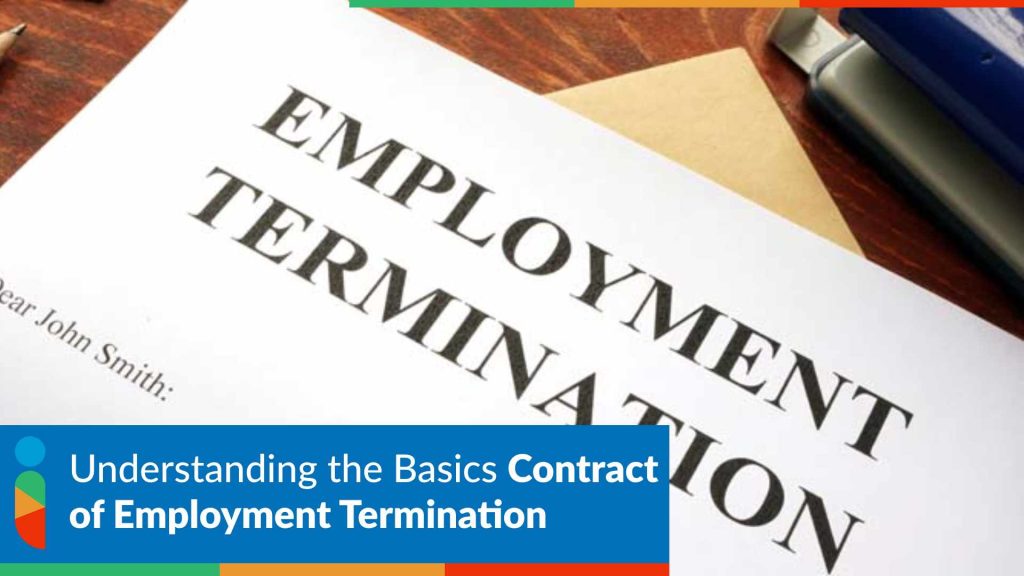Getting through the intricacies of employment, understanding the basics of contract termination is paramount. In the dynamic landscape of professional engagements, the contract of employment termination is a critical aspect that both employers and employees need to comprehend thoroughly. From contractual clauses to legal implications, we unravel the intricacies to empower individuals with the knowledge necessary for informed decision-making.
“Generally speaking, an employer cannot terminate an indefinite term contract after the trial time has passed without providing a statutory cause. Alternatively, the business may choose to give the employee a statutory termination payment in exchange for acknowledging that the termination was unfair or unreasonable.“
We will examine the essential elements of a contract of employment termination in this article, illuminating the important factors that control this crucial stage of the working relationship. Comprehending the legal frameworks, contractual duties, and the rights of both parties is imperative while navigating the terrain of job termination. We will act as a beacon of guidance, providing clarification on the crucial components that characterize the termination procedure.
Role of Notice Periods in Employment Termination

In the intricate realm of employment contract termination Spain, the role of notice periods stands as a crucial determinant. It shapes the dynamics of parting ways between employers and employees, particularly in the context of contact of employment termination. A notice period serves as a formal communication mechanism, expressing the purpose to terminate the employment relationship. It also helps providing both parties with a structured transition period.
Employment contracts embed notice periods, defining the required advance notice duration before termination takes effect. In Spain, employment contracts or collective bargaining agreements often specify the particulars of notice periods. It helps establishing a legal framework that both employers and employees must adhere to.
For employers, the notice period allows for the smooth management of workforce transitions. This provides the opportunity to plan for replacements and ensure continuity in business operations. On the employee’s side, it offers a window to seek alternative employment, prepare for the impending change, and secure financial stability during the transition.
Understanding the intricacies of notice periods is crucial for navigating employment contract termination Spain. The amount of notice is usually determined by factors including employment role, length of service, and any collective agreements that may be in place. The legal ramifications of not following to notice time requirements emphasize how crucial it is to fulfill these contractual responsibilities. As you can see, notice periods are crucial to the delicate dance of terminating an employment contract since they offer a methodical and equitable manner to part ways.
Employee Rights During Notice Periods
In the realm of employment contract termination Spain, the notice period serves as a crucial phase. There, employees retain specific rights, ensuring a fair and dignified transition. This period is marked by several key aspects that contribute to the overall balance of the termination process.
Firstly, employees maintain the right to continue performing their regular job duties and responsibilities throughout the notice period. This continuity not only provides a sense of stability but also allows individuals to fulfill their professional obligations. They do this until the termination becomes effective.
During this transitional phase, employees maintain their financial well-being by receiving their regular compensation and benefits. This ensures a degree of economic stability and underscores the commitment to treating employees fairly even during the termination process.
Moreover, navigating the complexities of employment contract termination in Spain involves a nuanced consideration of employee rights during notice periods. Ensuring equity and compliance, this comprehensive overview facilitates the termination process, allowing both parties to part ways with a sense of dignity and respect.
Art of Communicating Notice Periods
Mastering the art of communicating notice periods is a pivotal skill in the realm of terminate contracts of employment. Effectively conveying the impending conclusion of an employment relationship requires a delicate balance of clarity, empathy, and professionalism. This process not only aligns with legal obligations but also contributes to a positive and respectful experience for everyone.
The first step in this communication is to provide a written notice clearly articulating the decision to terminate the contract of employment. This notice should outline essential details, including the effective date of termination and any relevant information regarding the notice period.
By mastering this art, employers can navigate the process of contract of employment termination with professionalism and consideration. It will help foster an environment of mutual understanding and respect.
Negotiating Termination Terms Strategies for Employers
Firstly, initiating a direct and transparent conversation is paramount. Clearly communicate the reasons for the contract of employment termination, providing details and ensuring that the employee comprehends the decision. This upfront approach sets the foundation for a constructive negotiation process.
Offering alternatives and compromises during negotiations can foster a sense of fairness. Employers may explore options such as extended notice periods, financial assistance, or additional support services to ease the transition for the employee. This flexibility showcases a commitment to finding solutions that benefit both parties.
Documenting Termination Importance and Best Practices
Documenting termination is a critical aspect of contract of employment termination, and it serves as a cornerstone for legal compliance. Employers must prioritize the creation of a well-crafted employment termination contract letter to ensure a comprehensive record of the process. Understanding the importance and implementing best practices in documentation is essential.
On the other hand, clear and precise documentation contributes to legal compliance. The employment termination contract letter should align with employment laws and regulations, ensuring that the termination process adheres to requirements. This not only mitigates legal risks for employers but also upholds the rights of the employee in accordance with the law.
Best practices in documenting termination involve using language that is straightforward and unambiguous. Avoiding complex terminology or vague language helps create a document that is easily understandable and reduces the likelihood of misunderstandings.
Additionally, it is advisable to maintain a consistent format for an employment termination contract letter. Ensuring consistency in communication of essential information facilitates a streamlined process for both employers and employees.
Implementing a standardized documentation process for terminations across the organization promotes fairness and transparency. Establishing a clear protocol for documenting terminations fosters consistency in concluding employment relationships.
Dos and Don’ts of Employee Termination
Navigating employee termination involves a delicate balance of adherence to legal obligations and fostering a respectful atmosphere. Understanding the dos and Don’ts in the process of contract of employment termination is crucial for everyone.
Dos:
- Provide Clear Communication: Clearly communicate the reasons for contract of employment termination, ensuring that the employee comprehends the decision. Transparency is key to fostering understanding.
- Offer Constructive Feedback: Provide constructive feedback during exit interviews, focusing on areas of improvement rather than solely emphasizing the reasons for termination. This supports the employee’s growth.
- Create a Termination Letter: Moreover, document the termination with a well-crafted termination letter. Include essential details such as the effective date, reasons for termination, and any relevant terms and conditions.
- Be Empathetic: Acknowledge the emotional impact of termination, expressing gratitude for the employee’s contributions. An empathetic approach contributes to a positive atmosphere even during a challenging time.
- Follow Legal Compliance: Furthermore, adhere to employment laws and regulations to ensure legal compliance. Understanding the legal framework surrounding terminations is essential for safeguarding both parties rights.
Don’ts:
- Avoid Ambiguity: Avoid using ambiguous language or providing unclear reasons for termination. Ambiguity can lead to misunderstandings and potentially escalate the situation.
- Refrain from Delaying Communication: Do not delay communication of the termination decision. Timely communication is respectful and allows both parties to plan for the transition.
- Do not Withhold Information: Avoid withholding essential information about the termination. Open and honest communication contributes to a smoother process.
- Avoid Making Personal Attacks: Refrain from personal attacks or derogatory comments during the termination process. Maintain professionalism to preserve the dignity of the employee.
- Do not Neglect Legal Obligations: In addition, neglecting legal obligations in the termination process can lead to legal complications. Stay informed and ensure compliance with applicable employment laws.
Employee Feedback in Termination
Employers should encourage open dialogue during exit interviews, allowing employees to share their feedback on various aspects of their employment experience. This feedback can encompass work environment, management styles, job responsibilities, and any challenges faced.
Managing challenging terminations requires HR professionals to navigate with sensitivity and professionalism while concluding a contract of employment.
Moreover, the feedback session serves as a platform for constructive discussions about potential areas for improvement and professional development. This approach aligns with the principle of treating employees with respect and dignity, even during the challenging process of termination.
Handling Difficult Terminations Tips for HR Professionals

The key to a successful termination meeting is preparation. HR professionals should make sure they have all the required paperwork and are knowledgeable about the reasons behind the termination.
- Select the Appropriate Environment: To preserve privacy and lessen emotional anguish, choose a quiet, neutral location for the termination meeting.
- Show Empathy: Throughout the chat, show compassion and understanding, admitting how tough the situation is and expressing your appreciation for the worker’s efforts.
- Give Resources: Provide details on available support services, such counseling or outplacement programs, to help the employee move on to their next phase of life.
Visit our insights area to read more articles if you’re interested. However, if you want to hire our services, head up to our contact section






